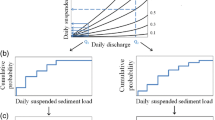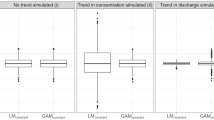Abstract
Modeling nonlinearity and thresholds in dose-effect relations is a major challenge, particularly in noisy data sets. Here we show the utility of nonlinear regression with additive monotone regression splines. These splines lead almost automatically to the estimation of thresholds. We applied this novel method to explore the relation between the toxicity of aquatic sediments, as observed in bioassays with Daphnia magna, Chironomus riparius and Vibrio fischeri, and the degree of contamination of the sediments. Despite the low signal-to-noise ratio in the data, some interesting thresholds and (non)linear effects were found. The method has added value compared to the linear multivariate methods applied earlier to these data. Percentages of explained variance remained low, but could be doubled by diminishing the effect of local variability.
Similar content being viewed by others
References
Akaike, H. (1973). Information theory and an extension of the maximum likelihood principle. In B.N. Petrov and F. Csaki (eds). 2nd International Symposium on Information Theory, pp. 267–81. Budapest: Akademia Kiado.
Bishop, Y.M.M., Fienberg, S.E. and Holland, P.W. (1975). Discrete Multivariate Analysis. Cambridge: MIT Press.
Brils, J.M. and Van den Hurk, P. (1994). Statistical analysis of bioassay results. Relation between biological and chemical parameters. Report 94.0454. Amsterdam, The Netherlands (in Dutch): AquaSense Laboratory.
Chapman, P.M. (1986). Sediment quality criteria from the sediment quality triad: an example. Environ. Toxicol. Chem. 5, 957–64.
Cornelissen, G., Rigterink, H., Ten Hulscher, D.E.M., Vrind, B.A. and Van Noordt, P.C.M. (2000). A simple tenax extraction method to determine the availability of sediment-sorbed organic compounds. Environ. Toxicol. Chem. 20(4), 706–11.
CUWVO (1990). Recommendations for the monitoring of compounds of the M-list of the national policy document on water management “Water in the Netherlands: A time for action”. The Hague, The Netherlands (in Dutch).
Den Besten, P.J., Schmidt, C.A., Ohm, M., Ruys, M.M., Van Berghem, J.W. and Van de Guchte, C. (1995). Sediment quality assessment in the delta of rivers Rhine en Meuse based on field observations, bioassay and food chain implications. J. Aquat. Ecosyst. Health. 4, 257–70.
Den Besten, P.J. (1997). Biotic effects caused by sediment pollution in the delta of the river Rhine and Meuse (Netherlands). Part II: Hollandsch Diep and Dordtsche Biesbosch. Report No. 97.098. p. 144 (in Dutch). Lelystad, The Netherlands: Institute for Inland Water Management and Waste Water Treatment (RIZA).
Den Besten, P.J. (1998). Concepts for the implementation of biomarkers in environmental monitoring. Mar. Env. Res. 46, 253–6.
Den Besten, P.J., Postma, J.F., Wegener, J.W.M., Keidel, H., Klink, A., Mol, J. and Van de Guchte, C. (2000). Biological and chemical monitoring after pilot remediations in the delta of the rivers Rhine and Meuse. J. Aquat. Ecosyst. Health. 3, 317–34.
Genstat 5 Committee (1993). Release 3, Reference Manual. Oxford: Clarendon Press.
Genstat 5 Committee (1997a). Release 4.1, Reference Manual Supplement. Oxford: Clarendon Press.
Genstat 5 Committee (1997b). Procedure Library Manual Release PL10. Oxford: Clarendon Press.
Goedhart, P.W. and Thissen, J.T.N.M. (eds) (1998). CBW Genstat Procedure Library Manual Release 4.1. CBW-report, Wageningen, The Netherlands.
Hastie, T.J. and Tibshirani, R.J. (1990). Generalized Additive Models. London: Chapman & Hall.
Houba, V.J.G., Lexmond, Th. M., Novozamsky, I. and Van der Lee, J.J. (1996). State of the art and future developments in soil analysis for bioavailability assessment. Sci. Total Environ. 178, 21–8.
Kersting, K. and Van den Brink, P.J. (1997). Effects of the insecticide dursban®4E (active ingredient chlorpyrifos) in outdoor experimental ditches: III. responses of ecosystem metabolism. Environ. Toxicol. Chem. 16, 251–9.
Maas, J.L., Van de Guchte, C. and Kerkum, F.C.M. (1993). Methods for the assessment of contaminated sediments according to the Triad approach (in Dutch). Report 93.027. Lelystad The Netherlands: Institute for Inland Water Management and Waste Water Treatment (RIZA).
Novozamsky, I., Lexmond, Th.M. and Houba, V.J.G. (1993). A single extraction procedure of soil for evaluation of uptake of some heavy metals by plants. Int. J. Environ. Anal. Chem. 51, 47–58.
Postma, J.F., De Valk, S., Dubbeldam, M., Maas, J.L., Tonkes, M., Schipper, B.J. and Kater, C.A. (2001). Confounding factors in bioassays with freshwater and marine organisms. Ecotox. Environ. Safety. (submitted).
Postma, J.F., Den Besten, P.J. (2001). Biotic effects caused by sediment pollution in the delta of the river Rhine and Meuse (The Netherlands). Part IV: Sliedrechtse Biesbosch. Report 01.027 (in Dutch). Lelystad, The Netherlands: Institute for Inland Water Management and Waste Water Treatment (RIZA).
Ramsay's, J.O. (1988). Monotone regression splines in action. Stat. Sci. 3, 425–1.
Reinhold-Dudok van Heel, H.C. and Den Besten, P.J. (1999). The relation between macroinvertebrate assemblages in the Rhine-Meuse delta (The Netherlands) and sediment quality. J. Aquat. Ecosyst. Health. 2, 19–38.
Rotteveel, S.G.P. and Den Besten, P.J. (2002). Differentiating metal from ammonia toxicity in identification evaluations. Environ. Contam. Toxicol. 69, 576–585.
Ten Hulsher, D.E.M., Cornelissen, G., Wilkens, M., Postma, J.F. and Van der Guchte, C. (2000). Tenax extraction predicts bioavailability of PAHs and PCBs for oligochaetes in Lake Ketelmeer sediments. Technical report (in Dutch). Lelystad, The Netherlands: Institute for Inland Water Management and Waste Water Treatment (RIZA).
Van de Guchte, C. (1992). The sediment quality triad: an integrated approach to assess contaminated sediments. In P.J. Newman, M.A. Piavaux and R.A. Sweeting (eds). River Water Quality, Ecological Assessment and Control. Brussels-Luxembourg: EdECSC-EEC-EAEC.
Author information
Authors and Affiliations
Corresponding author
Rights and permissions
About this article
Cite this article
De Boer, W.J., Den Besten, P.J. & Ter Braak, C.F. Statistical Analysis of Sediment Toxicity by Additive Monotone Regression Splines. Ecotoxicology 11, 435–450 (2002). https://doi.org/10.1023/A:1021057301583
Issue Date:
DOI: https://doi.org/10.1023/A:1021057301583




